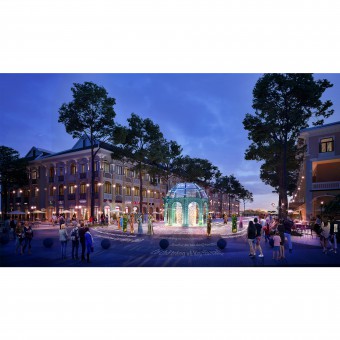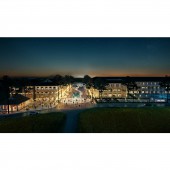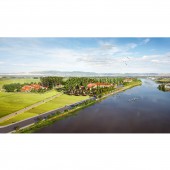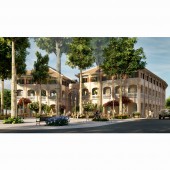
| THE AWARD |
| CATEGORIES |
| REGISTRATION |
| SUBMIT YOUR WORK |
| ENTRY INSTRUCTIONS |
| TERMS & CONDITIONS |
| PUBLICATIONS |
| DATES & FEES |
| METHODOLOGY |
| CONTACT |
| WINNERS |
| PRESS ROOM |
| GET INVOLVED |
| DESIGN PRIZE |
| DESIGN STORE |
| THE AWARD | JURY | CATEGORIES | REGISTRATION | PRESS | WINNERS | PUBLICATIONS | ENTRY INSTRUCTIONS |
The Pilgrimage Cbt Development by Scene Plus |
Home > Winners > Design #120191 >Interview |
 |
|
FS: What is the main principle, idea and inspiration behind your design?
SC: - The main principle throughout our designs: Based on inherent material and immaterial values, which is the identity of each sites: History, Culture, Landscape, People ... then come up with specific design ideas, only for each unique sites. - The inspiration for the design of "Pilgrimage to Lang Song" comes from the historical story of the formation of Quoc Ngu (the Vietnamese national script), the value of the agricultural landscape of the rice fields around the Lang Song Minor Seminary and the mixed architectural elements in the area (the Minor Seminary itself and neighboring structures in the area). The name Lang Song itself, the village on the riverbank, in English is River Village is also an inspirational element.
FS: What has been your main focus in designing this work? Especially what did you want to achieve?
SC: - Develop the area around Lang Song Minor Seminary, forming a whole that honors the architectural and landscape values inherent in the new urban context of the area. - Bringing the story about Quoc Ngu script and Lang Song printing house out of the campus of the minor seminary; Creating Heritage values for the region, intangible culture as well as economic development for indigenous people.
FS: What are your future plans for this award winning design?
SC: Take the next steps to bring the project to fruition.
FS: How long did it take you to design this particular concept?
SC: 3 years, including fieldwork and site survey
FS: Why did you design this particular concept? Was this design commissioned or did you decide to pursuit an inspiration?
SC: We are A multi-disciplinary team composed by architects and urban planner and tourism experts working on projects of Community Based Tourism - CBT in Binh Dinh province, a region in developing in the central coast of Vietnam. Pioneer in developing the concept of living-lab, we organize the On-site workshops is a New Model where the 4 sectors: Government- Academy- Enterprise- Society have the opportunity to work together in the context of shared economy, innovation and creative. From the result of those workshops, we propose the Master plans of the city, create the new developments in an harmony with the preserving fishing villages and traditional residential areas... Through the on-site workshops, in collaboration with businesses, local communities and universities creates employment opportunities for students, for the local people including many women, educates the children on foreign language, computer, pushes tourism, culture exchanges, the conservation the local life style and traditional culture. This design is to preserve and promote the intangible cultural values related to the national language, and at the same time create a community based tourism development to create an ecosystem that links tourism with culture, life, economic development of the people of Lang Song. The design pursues an inspiration throughout which is the source of Quoc Ngu script, along with the mission of recreating a living space that integrates with the natural environment, culture and what exists here.
FS: Is your design being produced or used by another company, or do you plan to sell or lease the production rights or do you intent to produce your work yourself?
SC: In order for the inspiration and design ideas not to be transformed by any intermediary or other organization or investor, and at the same time to carry out the mission of preserving the Source of Quoc Ngu script, we decided to "engage" with this project, from design to implementation.
FS: What made you design this particular type of work?
SC: One of the important goals is to develop the region in the context of the development of the country as a whole, this development is associated with the respect and preservation of the cultural heritage (tangible and intangible) of the country, regions. Avoid the phenomenon of urban development in a "barbaric" style, just for short-term economic purposes that destroy the inherent values of the area, lose the identity that has been taking place in Vietnam.
FS: Where there any other designs and/or designers that helped the influence the design of your work?
SC: In addition to ScenePlus's team of architects, tourism and culture experts in Vietnam. We also have consulting support from French Architect Lecaron. This helps us to have a multi-dimensional, multi-cultural view and give the most objective assessment. The connection, support and exchange between two groups of Vietnamese-French experts, similar to the original spirit of the formation of Quoc Ngu script, is the fruit of East-West cultural interference, East meets West.
FS: Who is the target customer for his design?
SC: Investors who have a common vision, to accompany in exploiting and economic development, not only for their own businesses, but also for the economic values of the region and the population, in a respectful context, preserving the heritage value of the area.
FS: What sets this design apart from other similar or resembling concepts?
SC: The Quoc Ngu printing house in the Lang Song Minor Seminary, the only remaining place that used to be one of the three Quoc Ngu script printing houses, and the Quoc Ngu script itself, which is derived from the Latin script, is a very important element in the development process of Vietnam. It has created great advantages for accessing and exchanging cultures with countries around the world, especially with Western civilization and technology. Quoc Ngu script helps to reduce the influence of the hieroglyphic culture that existed long before (over 1000 years) in Vietnam. The design associated with this site is therefore unique, with no similar or resembling concept.
FS: How did you come up with the name for this design? What does it mean?
SC: The Lang Song Minor Seminary itself is a site of religious pilgrimages today and used to be one of the first printing houses of Quoc Ngu script in Vietnam. "Pilgrimage" in the name of the design is also a reflection on the value of forming the Quoc Ngu, finding the "origin", telling the story with "gratitude" for the Quoc Ngu script and even the Western missionaries who has created and developed this language.
FS: Which design tools did you use when you were working on this project?
SC: - Site survey - Flycam scan images, measure 3D terrain - Hand sketches , sketchup, lumion and photoshop for rendering - Workshops - Interviews to collect the opinions of residents, Fathers, the authorities, the small business
FS: What is the most unique aspect of your design?
SC: - Condensing and summarizing intangible cultural values in a physical-architecture and urban landscape project. So that users can hear, see, touch, feel and understand the most primitive and true cultural values of the history of Quoc Ngu script.
FS: Who did you collaborate with for this design? Did you work with people with technical / specialized skills?
SC: - Design is created in collaboration with stakeholders: Local people, tourism experts, economy, culture, architects. We also work with local authorities, GIS analysts, heritage and history experts, Fathers and Sisters of Seminary
FS: What is the role of technology in this particular design?
SC: - Flycam scan images, measure 3D terrain - We use drones to take photos and videos to provide many perspectives on the project, and the surrounding landscape. - Technology helps us build a realistic 3D terrain model, providing visual information about the area's current topography and surface - Using tools Argis, GIS, Simulation of flood scenarios affecting in the lower Ha Thanh river area In addition, the technology of lighting, AI in the implementation of the Square will help the outdoor space exhibition to be effective.
FS: Is your design influenced by data or analytical research in any way? What kind of research did you conduct for making this design?
SC: Design is directly influenced by data and analytical studies of the status quo. This is not a design that brutally imposes a subjectivity on the status quo but a design created by analytic assessments of the status quo. From there, maximize the advantages and minimize the existing disadvantages, in order to create a design suitable for the status quo, promoting cultural values and core positions. To achieve that, we conduct a series of parallel researches including: - Survey to collect opinions of people, relevant authorities, departments according to living lab method. - Scan 3D terrain, record current data. - Analyze data analysis. - Up moodboard, mission and design concept. In addition, the design is influenced by: Flow study, hydraulic calculation of the area. Adjust the planning to ensure flood drainage according to the study of the Department of Agriculture and Rural Development, supplement the land fund for resettlement in the riverside alluvial area.
FS: What are some of the challenges you faced during the design/realization of your concept?
SC: - The biggest challenge we faced in the design process was how to convey "enough", "correctly" the intangible cultural values into a tangible work while still integrating with the culture and existing status quo, not impose, neither to be subjective. How to design effectively, both protect and promote heritage values in the general development context of the city.
FS: How did you decide to submit your design to an international design competition?
SC: - Good cultural values should be preserved and spread for everyone to know, and being recognized in an international competition is a great honor and encouragement for our team. And A'design is an international design competition that meets those requirements.
FS: What did you learn or how did you improve yourself during the designing of this work?
SC: - This design process helps us to consolidate solid logic and methodology and understand how to reconcile design with what is in existence. - Learn an integrated approach from the perspective of heritage landscape towards economic development.
FS: Any other things you would like to cover that have not been covered in these questions?
SC: We plan to continue bringing this design to the UNESCO-Greece Melina Mercouri International Prize nomination for the Safeguarding and Management of Cultural Landscapes. The purpose is to promote the cultural heritage of Quoc Ngu script - a fruit of East meets West culture, and at the same time to raise the awareness and understanding of the local community about conservation and promotion the heritage value in the new era, bringing opportunities for economic development, creating jobs for local people, developing community based tourism, sustainable tourism.
FS: Thank you for providing us with this opportunity to interview you.
A' Design Award and Competitions grants rights to press members and bloggers to use parts of this interview. This interview is provided as it is; DesignPRWire and A' Design Award and Competitions cannot be held responsible for the answers given by participating designers.
| SOCIAL |
| + Add to Likes / Favorites | Send to My Email | Comment | View Press-Release | Translations |





